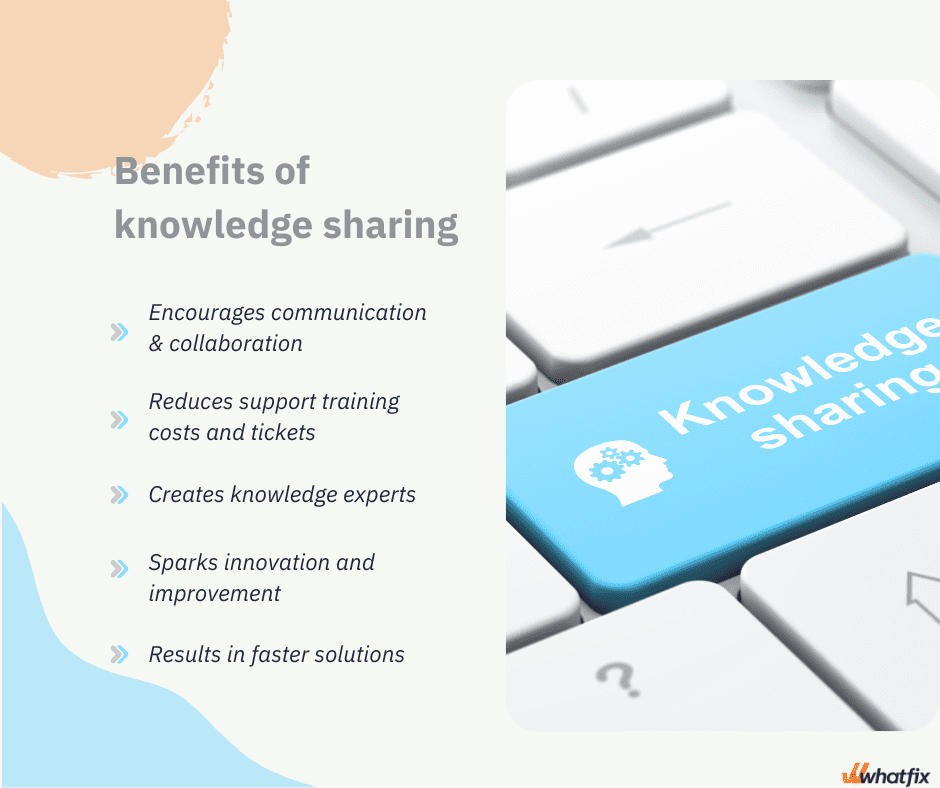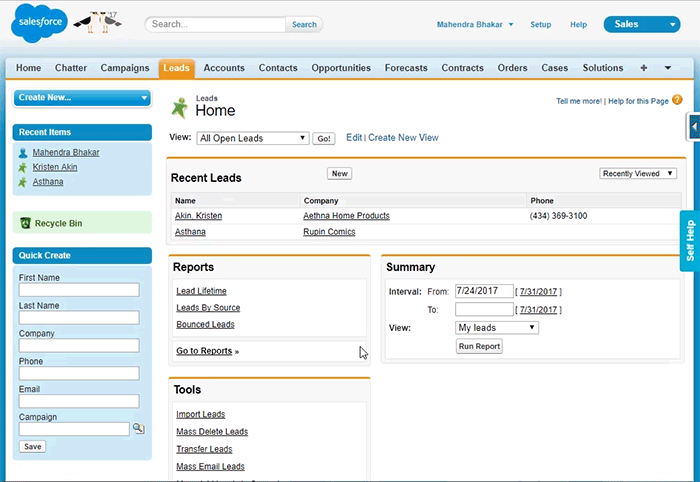

Levi Olmstead


In this fast-paced and interconnected world, knowledge sharing has emerged as a key driver of organizational success and innovation. As businesses strive to remain competitive and adaptable, the ability to effectively share knowledge among employees becomes crucial.
Knowledge sharing fosters collaboration, enhances problem-solving capabilities, and accelerates learning and growth across teams. In this article, we delve into the significance of knowledge sharing in modern workplaces, explore the benefits it offers to both individuals and organizations, and provide practical strategies to promote a culture of knowledge sharing. By harnessing the power of knowledge sharing, businesses can unlock their full potential, encourage continuous improvement, and pave the way for a more collaborative and thriving future.
Knowledge sharing refers to the intentional act of exchanging information, expertise, ideas, insights, and experiences among individuals or teams within an organization. It involves the voluntary dissemination of knowledge and expertise to enhance the collective understanding and capabilities of others.
Knowledge sharing can take various forms, such as informal conversations, formal training sessions, documentation, collaboration platforms, and online knowledge repositories. This process promotes collaboration, fosters innovation, and enables continuous learning and growth, ultimately leading to improved decision-making and overall organizational effectiveness.
Knowledge sharing and knowledge management are two related but distinct concepts within an organization’s information ecosystem.
Knowledge sharing refers to the act of transferring information, insights, skills, or expertise from one individual or group to others within the organization. It is a collaborative process where employees voluntarily share their expertise, and best practices with their peers to enhance collective learning and problem-solving. Knowledge sharing encourages open communication, teamwork, and a culture of learning, leading to improved decision-making and increased innovation.
Knowledge management, on the other hand, involves the systematic process of capturing, organizing, storing, and disseminating knowledge and information within an organization. The process of knowledge management involves the entire lifecycle of knowledge, from creation to application and preservation. Knowledge management utilizes a number of tools and systems including databases, knowledge repositories and intranets.
Information hoarding takes place when an individual withholds information intentionally and refrains from sharing it with other team members. This can lead to multiple functional issues in an organization and overdependence on the person hoarding information.
Here are a few signs that will help you identify knowledge hoarding in an organization:

Here are some of the most significant benefits of knowledge sharing.

Establishing a process for knowledge sharing makes it easier for people to work collaboratively and communicate what they know to their team. It adds actionable steps to a process that otherwise may not happen consistently—it lets your staff know when and how to share their expertise.
Employees are sometimes hesitant to share their knowledge (a practice known as “knowledge hoarding”). This behavior can be influenced by various factors, including:
Cultivating a culture of knowledge sharing within the organization can serve as a remedy to such hindrances. It also ensures that valuable knowledge makes it across company silos, so employees from different teams or departments still get the opportunity to learn from each other.
Large companies lose, on average, $47 million per year in productivity because they don’t have efficient systems set up for knowledge sharing. Employees take longer to complete projects and end up feeling frustrated while they struggle to get the information they need to get their work done. They may also lean on the company’s IT department to solve small problems that they could address themselves.
Knowledge-sharing systems simplify this process. If an employee feels lost on how to solve a problem, they can turn to a knowledge base to find the answers they need. This allows team members to learn how to use the tools needed for their jobs and get their work done faster. Consequently, this approach relieves the burden on resident experts and the IT department, who would otherwise be inundated with troubleshooting requests, thereby enhancing overall efficiency and productivity.
Knowledge sharing can be an empowering experience for everyone involved. It allows the workforce to accumulate information and skills that would’ve been tough to build if they were doing it alone. The process leverages the existing, internal experts and helps create new experts out of the rest of the team.
The existing experts receive public recognition as masters in their field—their skills, opinions, and experience becomes the gold standard for the organization. Other team members get the benefits of mentorship, allowing them to grow their own knowledge and progress in their career goals.
Knowledge sharing gives a team the power to tackle complex problems by allowing them to build on each other’s solutions. It fosters an innovative environment where staff members can lean on one another for problem-solving instead of shouldering burdens solo.
In 2018, a team of researchers studied how knowledge sharing allowed for more innovation in online programming competitions. In each contest, competitors had one week to solve the same coding challenge. Each contest submission was public, so competitors could reference submissions as they came in, using them to inspire their own solutions.
Researchers found that overall performance increased steadily over time because competitors were allowed to borrow and “tweak” the work of their predecessors. This environment also allowed for “innovative leaps” or moments where a competitor made major changes to the status quo.
Knowledge sharing can provide employees with a similar jumping-off point when they’re faced with sticky problems. By accessing and iterating on existing organizational knowledge, they can either make efficient tweaks for streamlining processes or take major innovative leaps to provide a significant process improvement for the whole company.
When all information is organized systematically in one place, employees can perform tasks independently leading to faster executions. The interdependence on other team members reduces drastically. This also provides an opportunity to leverage collective experience of all team members.
New employees can benefit from the experiences of their more experienced colleagues through knowledge sharing. This speeds up their learning curve, helping them become productive and proficient in their roles quickly.
According to a 2020 survey from Deloitte, 75% of companies agreed that knowledge sharing is “important or very important for their success over the next 12–18 months.” However, only 9% felt prepared to implement knowledge-sharing processes on their own organization.
Here are a few steps to cultivate a culture of knowledge sharing in your organization:
A good knowledge management system must be accessible to all employees, and it might be beneficial for the organization to hire and designate an individual as the knowledge manager to oversee the process. The knowledge manager is responsible for various key tasks, including:
The necessity of a knowledge manager may vary depending on the size of the organization. While smaller startups may not require such a dedicated role, larger companies with extensive workforces can derive significant benefits from hiring a knowledge manager.
Investing in the right tool can streamline your information flow enabling efficient knowledge sharing within the company. To build a knowledge management system in an organization, leaders should consider implementing:
The right knowledge management tools can enhance productivity, collaboration and boost the company’s productivity exponentially.

Creating a set of internal guidelines to explain how employees should share their knowledge can make the process easier for them to follow. These guidelines should be simple to understand and actionable. If the organization includes a knowledge manager, they could own this process and even offer to train employees on how to use the knowledge management system.
The guidelines should offer specific directions on:
You can also teach your staff how to navigate the system using digital adoption software like Whatfix. With Whatfix, your staff can get in-app, step-by-step instructions on how to add their own resources and use the knowledge database effectively.
Knowledge sharing only works if employees participate in the process. That means they need the time and incentive to do so, and it means their managers will need to be willing to carve out time for their employees to create knowledge-sharing resources.
Asking your employees to write down their go-to processes or create tutorials can be an empowering experience for them. It allows them to take ownership of their knowledge and skills while presenting themselves as experts to their colleagues.
Your staff may need guidance from you or from your knowledge manager on the best way to document things in a way that’s easy to understand. This is another area where it may help to create a set of internal guidelines to help them along.

Above: With Whatfix, organizations can create in-app self-help knowledge bases that empower employees to find and share answers to FAQs on-demand, in the flow of work in common work software such as the Salesforce example above.
Norms play an important role in knowledge sharing. People may be more likely to engage in altruistic behavior (knowledge sharing included) if they see that it’s the norm within the organization. Showing the staff how to share knowledge and why they should inculcate knowledge sharing helps encourage those who would typically keep quiet with their co-workers about what they know.
Establish company norms around knowledge sharing by encouraging your leadership team to model it as well. The people in your organization will follow your lead.
Scheduling informal lunch and learning events can offer a fun way to build community, break the ice, and make people feel more willing to share. Each event can be recorded and saved in the knowledge repository for future reference.
Some lunch and learn ideas include :
Knowledge sharing as a part of the company culture should be disseminated to the new employees via their mentors. New employees should have access to all necessary information and their queries should be well answered. Continuous support by a mentor in the beginning enables the new employee to adapt to the organization faster and move along the learning curve easily.
Mentors can share loom videos on certain processes, give access to company archives and stay connected with the new employee on Slack, Microsoft Teams, or any other communication tool used by the company. This will help the new employee understand the culture of knowledge sharing within the organization.
Incentivizing employees for sharing their insights can be a great practice to encourage knowledge sharing in the company. A reward system can be put in place using frequent “ideathons” or brainstorming sessions wherein the best ideas can be rewarded by a public recognition, bonus or a voucher.
Here are some examples of a knowledge sharing culture.
Using Slack instead of your regular texting application can help the organizational information be differentiated from the personal information.
Confluence, on the other hand, helps in internal blogging. Employees can record their learnings, wins, and ideas across the organization using Confluence. This also helps cut down on meetings without compromising on essential communication.
Combining knowledge sharing platforms like slack and confluence enables efficient, immediate and systematically documented knowledge sharing within the organization.
In-house newsletters are a great mechanism to keep everyone in a company informed and updated. The newsletters can be circulated bi-weekly or monthly and should consist of crucial information like-
These newsletters play a very important role in keeping all employees in loop about the advancements in the company.
Job shadowing helps encourage cross-functional understanding and knowledge exchange. It offers a hands-on and immersive learning experience that allows the individual to gain insights into the practical aspects of the job, understand the responsibilities, and observe the skills and techniques used by the experienced employee. In case of succession planning, especially, job shadowing can be a great knowledge transfer mechanism.
The most common barriers that hinder knowledge sharing in an organization are:
A company’s culture can significantly impact knowledge sharing. In some organizations, there may be a lack of emphasis on collaboration and knowledge exchange. Employees might be hesitant to share information due to a competitive or siloed culture, where knowledge is seen as a source of power and job security. Overcoming this barrier requires fostering a culture that values and rewards knowledge sharing, promoting open communication, and emphasizing the collective benefits of sharing expertise.
Employees may be less inclined to share their knowledge if there are no clear incentives or recognition for doing so. When knowledge sharing is not linked to performance evaluations or career advancement opportunities, employees might prioritize other tasks over sharing valuable insights. Implementing recognition programs, providing opportunities for skill development based on knowledge sharing, and incorporating knowledge sharing into performance evaluations can incentivize employees to actively participate in knowledge exchange.
Poor communication channels and inadequate technology can hinder knowledge sharing. If employees struggle to access information or face challenges in finding relevant knowledge repositories, they may be discouraged from engaging in knowledge-sharing activities. Providing user-friendly collaboration tools, improving internal communication channels, and investing in knowledge management systems can remove these barriers and facilitate seamless knowledge exchange within the organization.
Digital adoption platforms (DAPs) play a pivotal role in enabling a knowledge-sharing culture within organizations by simplifying the adoption of digital tools and promoting collaboration. DAPs offer interactive and context-sensitive training, allowing employees to quickly learn and leverage new technologies, which in turn increases their confidence and proficiency in sharing their expertise with colleagues.
These platforms also act as a central hub for sharing best practices, tips, and insights, fostering a collaborative environment where employees can contribute and access valuable knowledge. Furthermore, DAPs track user interactions, providing data-driven insights that help identify knowledge gaps and areas where additional support or training is needed. By streamlining digital adoption, DAPs empower employees to embrace new technologies, leading to enhanced knowledge sharing, increased productivity, and a culture of continuous learning and growth within the organization.
To know more about how Whatfix can support your organization’s knowledge-sharing culture, schedule a demo with us today!
Thank you for subscribing!